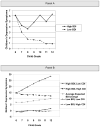Dynamic associations between maternal depressive symptoms and adolescents' depressive and externalizing symptoms
- PMID: 20607385
- PMCID: PMC3402354
- DOI: 10.1007/s10802-010-9433-y
Dynamic associations between maternal depressive symptoms and adolescents' depressive and externalizing symptoms
Abstract
The current prospective study investigated transactional relations between maternal depressive symptoms and children's depressive and externalizing symptoms. Participants included 240 children (M age = 11.86 years, SD = 0.56; 53.9% female) and their mothers who were part of a 6-year longitudinal study. Measures of maternal depression (Beck Depression Inventory), child depression (Children's Depression Inventory), and children's externalizing symptoms (Youth Self-Report Form) were assessed annually. Data analyses using dynamic latent difference score structural equation models indicated that the observed relations between mothers' and adolescents' symptoms were stable across the 6 years. Higher levels of maternal depressive symptoms predicted subsequent elevations in children's depressive symptoms and in their externalizing problems over time. Among mothers with high initial levels of depression, children's depressive symptoms predicted subsequent declines in mothers' depressive symptoms. Children's externalizing problems were not related to subsequent change in maternal symptoms.
Figures


Similar articles
-
Effortful control moderates bidirectional effects between children's externalizing behavior and their mothers' depressive symptoms.Child Dev. 2014 Mar-Apr;85(2):643-58. doi: 10.1111/cdev.12123. Epub 2013 May 13. Child Dev. 2014. PMID: 23668713 Free PMC article.
-
Infant functional regulatory problems and gender moderate bidirectional effects between externalizing behavior and maternal depressive symptoms.Infant Behav Dev. 2013 Jun;36(3):307-18. doi: 10.1016/j.infbeh.2013.02.004. Epub 2013 Mar 30. Infant Behav Dev. 2013. PMID: 23545078 Free PMC article.
-
Emotional reactivity mediates and moderates the longitudinal associations between mothers' depressive symptoms and behavioral problems in youth.J Res Adolesc. 2025 Mar;35(1):e13042. doi: 10.1111/jora.13042. Epub 2024 Dec 1. J Res Adolesc. 2025. PMID: 39616496
-
Maternal depressive symptoms: associations with adolescents' internalizing and externalizing problems and social competence.Nord J Psychiatry. 2014 Jul;68(5):323-32. doi: 10.3109/08039488.2013.838804. Epub 2013 Sep 27. Nord J Psychiatry. 2014. PMID: 24070429
-
Externalizing symptoms, effortful control, and intrusive parenting: A test of bidirectional longitudinal relations during early childhood.Dev Psychopathol. 2015 Nov;27(4 Pt 1):953-68. doi: 10.1017/S0954579415000620. Dev Psychopathol. 2015. PMID: 26439056 Review.
Cited by
-
What clinical differences distinguish depressed teens with and without comorbid externalizing problems?Gen Hosp Psychiatry. 2013 Jul-Aug;35(4):444-7. doi: 10.1016/j.genhosppsych.2013.04.002. Epub 2013 May 4. Gen Hosp Psychiatry. 2013. PMID: 23648192 Free PMC article.
-
The Mediating Role of Autonomy and Relatedness on Maternal and Child Outcomes.J Abnorm Child Psychol. 2018 Feb;46(2):209-221. doi: 10.1007/s10802-017-0303-8. J Abnorm Child Psychol. 2018. PMID: 28474188
-
Dynamic temporal relations between anxious and depressive symptoms across adolescence.Dev Psychopathol. 2013 Aug;25(3):683-97. doi: 10.1017/S0954579413000102. Dev Psychopathol. 2013. PMID: 23880385 Free PMC article.
-
Inhibitory control as a mediator of bidirectional effects between early oppositional behavior and maternal depression.Dev Psychopathol. 2014 Nov;26(4 Pt 1):1129-47. doi: 10.1017/S0954579414000613. Epub 2014 Jun 25. Dev Psychopathol. 2014. PMID: 24963884 Free PMC article.
-
Maternal depressive symptoms and child behavior problems: Attachment security as a protective factor.Dev Psychopathol. 2023 May;35(2):678-688. doi: 10.1017/S0954579421001802. Epub 2022 Jan 31. Dev Psychopathol. 2023. PMID: 35094731 Free PMC article.
References
-
- Achenbach TM. Integrative guide for the 1991 CBCL/4-18, YSR, and TRF profiles. Burlington: University of Vermont, Department of Psychiatry; 1991.
-
- Arbuckle JL. AMOS 16.0 user’s guide. Chicago, IL: SmallWaters Corporation; 2007.
-
- Beardslee WR, Versage EM, Gladstone TRG. Children of affectively ill parents: A review of the past 10 years. Journal of the American Academy of Child and Adolescent Psychiatry. 1998;37:1134–1141. - PubMed
-
- Beck AT, Ward CF, Mendelson M, Mock J, Erlbaugh J. An inventory for measuring depression. Archives of General Psychiatry. 1961;4:53–63. - PubMed
-
- Bentler PM. Comparative fit indexes in structural models. Psychological Bulletin. 1990;107:238–246. - PubMed
Publication types
MeSH terms
Grants and funding
LinkOut - more resources
Full Text Sources
Medical

